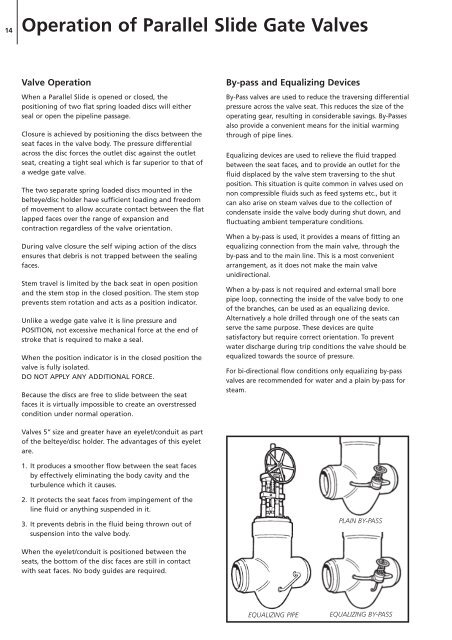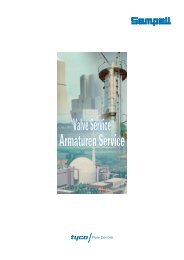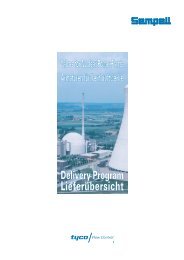Create successful ePaper yourself
Turn your PDF publications into a flip-book with our unique Google optimized e-Paper software.
14<br />
Operation of Parallel Slide Gate Valves<br />
Valve Operation<br />
When a Parallel Slide is opened or closed, the<br />
positioning of two flat spring loaded discs will either<br />
seal or open the pipeline passage.<br />
Closure is achieved by positioning the discs between the<br />
seat faces in the valve body. The pressure differential<br />
across the disc forces the outlet disc against the outlet<br />
seat, creating a tight seal which is far superior to that of<br />
a wedge gate valve.<br />
The two separate spring loaded discs mounted in the<br />
belteye/disc holder have sufficient loading and freedom<br />
of movement to allow accurate contact between the flat<br />
lapped faces over the range of expansion and<br />
contraction regardless of the valve orientation.<br />
During valve closure the self wiping action of the discs<br />
ensures that debris is not trapped between the sealing<br />
faces.<br />
Stem travel is limited by the back seat in open position<br />
and the stem stop in the closed position. The stem stop<br />
prevents stem rotation and acts as a position indicator.<br />
Unlike a wedge gate valve it is line pressure and<br />
POSITION, not excessive mechanical force at the end of<br />
stroke that is required to make a seal.<br />
When the position indicator is in the closed position the<br />
valve is fully isolated.<br />
DO NOT APPLY ANY ADDITIONAL FORCE.<br />
Because the discs are free to slide between the seat<br />
faces it is virtually impossible to create an overstressed<br />
condition under normal operation.<br />
Valves 5” size and greater have an eyelet/conduit as part<br />
of the belteye/disc holder. The advantages of this eyelet<br />
are.<br />
1. It produces a smoother flow between the seat faces<br />
by effectively eliminating the body cavity and the<br />
turbulence which it causes.<br />
2. It protects the seat faces from impingement of the<br />
line fluid or anything suspended in it.<br />
3. It prevents debris in the fluid being thrown out of<br />
suspension into the valve body.<br />
When the eyelet/conduit is positioned between the<br />
seats, the bottom of the disc faces are still in contact<br />
with seat faces. No body guides are required.<br />
By-pass and Equalizing Devices<br />
By-Pass valves are used to reduce the traversing differential<br />
pressure across the valve seat. This reduces the size of the<br />
operating gear, resulting in considerable savings. By-Passes<br />
also provide a convenient means for the initial warming<br />
through of pipe lines.<br />
Equalizing devices are used to relieve the fluid trapped<br />
between the seat faces, and to provide an outlet for the<br />
fluid displaced by the valve stem traversing to the shut<br />
position. This situation is quite common in valves used on<br />
non compressible fluids such as feed systems etc., but it<br />
can also arise on steam valves due to the collection of<br />
condensate inside the valve body during shut down, and<br />
fluctuating ambient temperature conditions.<br />
When a by-pass is used, it provides a means of fitting an<br />
equalizing connection from the main valve, through the<br />
by-pass and to the main line. This is a most convenient<br />
arrangement, as it does not make the main valve<br />
unidirectional.<br />
When a by-pass is not required and external small bore<br />
pipe loop, connecting the inside of the valve body to one<br />
of the branches, can be used as an equalizing device.<br />
Alternatively a hole drilled through one of the seats can<br />
serve the same purpose. These devices are quite<br />
satisfactory but require correct orientation. To prevent<br />
water discharge during trip conditions the valve should be<br />
equalized towards the source of pressure.<br />
For bi-directional flow conditions only equalizing by-pass<br />
valves are recommended for water and a plain by-pass for<br />
steam.<br />
PLAIN BY-PASS<br />
EQUALIZING PIPE EQUALIZING BY-PASS




